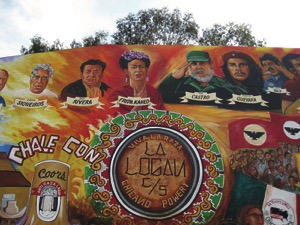
It’s a familiar pattern, oft repeated. A forgotten neighborhood is discovered by artists seeking good spaces and cheap rents. They move in and the process of gentrification begins. Before long, the rents are so high and home values so steep, that the artists have to look elsewhere for space. The neighborhood is so no longer forgotten; it has become chic.
Barrio Logan may be in the midst of such a transformation. Created in the late 1800s as proposed railroad land, it was named Logan Heights after the congressmen promoting the legislation. The railroad terminal location never materialized, and in the early 1900s the area was flooded with refugees from the Mexican Revolution, who re-coined the area Barrio Logan. And so it has remained a friendly community in the shadow of the San Diego-Coronado Bridge, predominantly Hispanic.
By 2010, changes were noticeable. The white population grew from 6 to 16 percent, and new enterprises began to crop up. Most significantly, artists began to discover the area and attracted by low rents and warehouse spaces, began to plant their flags. With the artists came the resources and businesses to serve their needs, like the Glashaus, a converted warehouse of artists’ studios, and a growing number of art galleries. The second Saturday of every month saw the Barrio Art Crawl, an event bringing new energy and new artists into the community.
The neighborhood was a natural. In 1920, occupiers and protestors created the murals of Chicano Park now considered to be the largest collection of outdoor murals in the United States. In 2013 the murals of Chicano Park were formally named a Historic Landmark.
The fact is that most artists prefer the spontaneity, friendliness and even cacophony of a neighborhood like the Barrio. One artist wrote about his attraction to a Hispanic family he saw watching TV in their front yard while neighbors walked by to ask the score, providing tacos to the homeless folks who chanced by. The diversity of the neighborhood and very openness was what attracted him to move into the community.
When the area begins to get too fancy and rents rise, the mom and pop businesses that gave the area its flavor, begin to get priced out, and in come the generic corporate faces we all know only too well. Gentrification becomes a self-fulfilling prophecy, in a sense.
The best times for a community are in the early stages when the area is filled with new people imparting their energy and enthusiasm to creating new businesses and gussying up their properties. Some of these new businesses to be found in Barrio Logan include The Church, an art collective in a former church; Cafe Moto, a great coffee spot; restaurants like Salud, known for its tacos and craft beers and Border X Brewing, a brewery featuring a beer made with Mexican hot chocolate. For cultural food, check out the Chicano Art Gallery, Bread and Salt, Atheneum Music and Arts Library, and my personal favorite, Las Cuatro Milpas serving Mexican fare since 1933.
Before the artists move out, Barrio Logan is a funky neighborhood with some great new energy, a young vibe, and lots to do and see. Get there soon while it is at its very best and is still itself.












The original name of the area is Logan Heights. It included what is now referred to as Barrio Logan (area West of Interstate 5), Logan Heights (East of Interstate 5) and Southeast San Diego. The name changed after the dissection that occurred in the 1960’s by Interstate 5 and the the San Diego-Coronado bay bridge. By 1970 the area population decreased from approximately 20,000 residents down to less than 5,000 residents in less than 15 years
The Chicano/Mexican community along with African Americans lived in this area because the area was segregated through early 1950’s and they could not live anywhere else.
The Murals were created after the community took over and occupied the land for 12 days to create Chicano Park after the City and State had approved a Ca. Higheay Patrol substation on the site where the community wanted a Park. This occurred on the original launching of Earth Day April 22, 1970 not in1920 as stated in the article.
The gentrification process tripled after the maritime industry put forward a referendum to overturn the City approved community development plan in 2013. The Community Plan was created after a five year democrats process that included stakeholders that included residents, maritime, suppliers, and local businesses. The maritime industry and their suppliers put forth a referendum by collecting signatures based on false information (los of Navy and maritime) to overturn the Community Plan. Preposition B and C were placed on the ballot and the whole City voted against the residents of Barrio Logan forcing them to operate under a plan approved on 1979.
Logan Heights was a self contained neighborhood with its own businesses, churches, entertainment and cultural centers prior to the decision to drive the freeway and bridge through it.